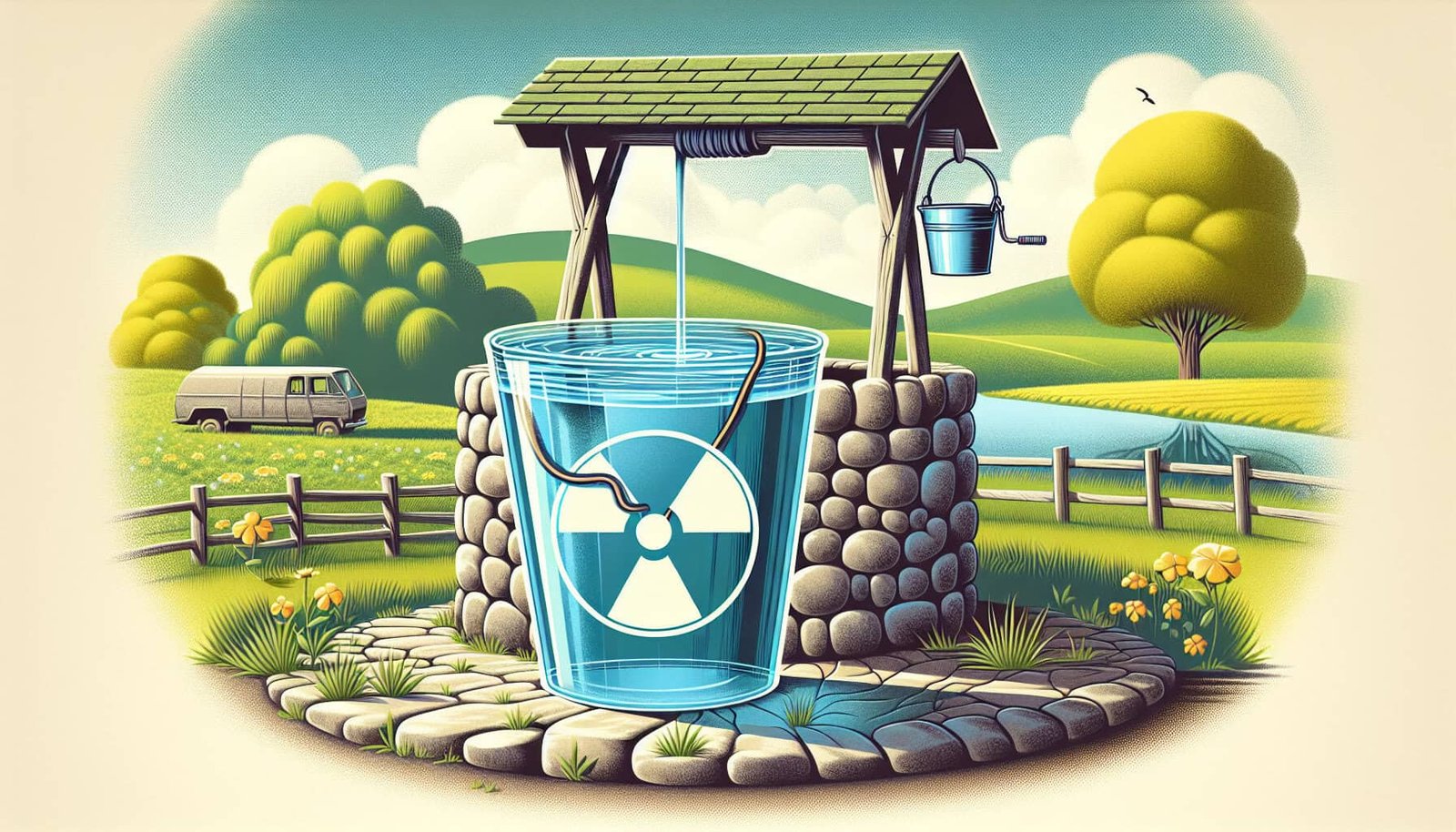Are you concerned about the presence of elevated cobalt-60 levels in your well water? If so, you may be wondering how to effectively address this issue. In this article, we will explore different methods and solutions to tackle the problem of cobalt-60 in well water. Whether you are looking for tips on prevention, filtration systems, or water treatment options, we’ve got you covered. So, let’s dive in and discover the best ways to address well water with elevated cobalt-60 levels!
Understanding Cobalt-60 Contamination in Well Water
What is Cobalt-60?
Cobalt-60 is a radioactive isotope of cobalt, a naturally occurring element. It is commonly used in medical and industrial applications, including in cancer radiation therapy and sterilization of medical equipment. It emits high-energy gamma radiation, which can be harmful to human health when ingested or inhaled in excessive amounts.
How does Cobalt-60 Enter Well Water?
Cobalt-60 can enter well water through various pathways. Industrial activities, such as nuclear power plants or metal processing facilities, may release cobalt-60 into the environment, where it can eventually contaminate groundwater sources. Additionally, natural geological deposits containing cobalt-60 can dissolve in water and leach into wells. It is crucial to identify the source of contamination to effectively mitigate its presence in well water.
Health Risks Associated with Elevated Cobalt-60 Levels
Exposure to elevated levels of cobalt-60 in well water can pose significant health risks. The gamma radiation emitted by cobalt-60 can damage cells and DNA, potentially leading to increased risks of cancer and other radiation-related illnesses. It is essential to address and manage cobalt-60 contamination promptly to safeguard your health and the well-being of your loved ones.
Assessing Cobalt-60 Levels in Well Water
Testing Well Water for Cobalt-60
To determine the presence and concentration of cobalt-60 in well water, specialized testing is required. Contact a certified water testing laboratory or environmental consultant to collect water samples and perform a thorough analysis. They will employ precise techniques, such as gamma spectroscopy, to provide accurate measurements of cobalt-60 levels in your well water.
Interpreting Cobalt-60 Test Results
Once you receive the test results, it is important to interpret them correctly. The laboratory will typically indicate the concentration of cobalt-60 in units such as becquerels per liter (Bq/L). It is crucial to compare these results with local and national safety standards to determine the extent of contamination in your well water. If the cobalt-60 levels exceed the recommended limits, it is crucial to take immediate action to mitigate the contamination.

Identifying the Source of Cobalt-60 Contamination
Potential Sources of Cobalt-60
Identifying the source of cobalt-60 contamination is a critical step in addressing the issue effectively. As mentioned earlier, potential sources can include industrial activities and natural geological deposits. By understanding the possible origins of cobalt-60 in your area, you can narrow down your investigation and focus on finding the specific source of contamination.
Investigating Local Industrial Activities
If there are nearby industrial facilities, including nuclear power plants or metal processing plants, it is vital to investigate their operations and waste management protocols. Reach out to local environmental agencies or regulatory bodies to obtain information about potential cobalt-60 discharges into the environment. Collaborating with these organizations can help in identifying whether the contamination is originating from nearby industrial activities.
Assessing Geological Factors
In some cases, cobalt-60 contamination may stem from natural geological factors. Conduct research or consult with hydrogeologists to understand the geological composition of your region. Certain geological formations may contain cobalt-rich minerals that can leach into the groundwater. Evaluating the geological factors can provide valuable insights into potential sources of cobalt-60 contamination.
Mitigating Cobalt-60 Contamination
Consulting with Water Treatment Specialists
Addressing cobalt-60 contamination in well water requires specialized expertise. Consulting with water treatment specialists, such as engineers or environmental consultants, can help determine the most suitable mitigation strategies for your specific situation. These professionals have the knowledge and experience to recommend effective treatment methods tailored to your well water quality and cobalt-60 levels.
Applying Appropriate Water Treatment Techniques
Based on the recommendations of water treatment specialists, you can implement appropriate techniques to mitigate cobalt-60 contamination. Several treatment methods have proven effective in reducing cobalt-60 levels in water:
Using Activated Carbon Filtration
Activated carbon filtration systems are commonly used in water treatment to remove various contaminants, including organic compounds and certain radioactive isotopes like cobalt-60. The activated carbon adsorbs the cobalt-60 particles, effectively reducing their concentration in the treated water. It is important to select a filtration system that can handle the specific requirements of your well water.
Reverse Osmosis Systems
Reverse osmosis systems utilize a semi-permeable membrane to separate contaminants from water molecules. This technology can effectively remove cobalt-60, along with other harmful substances, providing you with treated water that meets safety standards. Reverse osmosis systems are particularly effective for well water contaminated with cobalt-60 and other dissolved solids.
Ion-Exchange Resins
Ion-exchange resins are another viable option for mitigating cobalt-60 contamination. These resin materials attract and exchange ions in the water, substituting cobalt-60 ions with less harmful ions such as sodium or potassium. This process helps to lower the cobalt-60 levels in the water, ensuring it is safe for consumption.

Maintaining Water Quality After Treatment
Regular Testing and Monitoring of Well Water
After implementing treatment methods, it is crucial to regularly test and monitor the quality of your well water. Conduct periodic tests to confirm that cobalt-60 levels remain within acceptable limits. Maintaining a monitoring schedule will help ensure the effectiveness of your treatment strategies and provide early detection of any potential recontamination.
Ensuring Adequate Maintenance of Treatment Systems
Maintaining your water treatment systems is essential to ensure their continued effectiveness. Regularly inspect and clean the filtration media, membranes, or resins used in the treatment process. Follow the manufacturer’s instructions and consult with water treatment specialists to perform routine maintenance tasks, ensuring optimal performance and longevity of the system.
Monitoring Potential Recontamination Sources
Even after successful mitigation, it is important to remain vigilant about potential sources of recontamination. Stay informed about nearby industrial activities or changes in the geological landscape that may affect water quality. Regularly communicate with local environmental agencies and other relevant organizations to stay updated on any potential risks to your well water.
Considering Alternative Water Sources
Exploring Municipal Water Supply
If cobalt-60 contamination in your well water persists despite mitigation efforts, it may be necessary to explore alternative water sources. Contact your local municipality to inquire about the availability of a municipal water supply. Most municipal water systems adhere to strict quality standards and regular monitoring, offering a reliable and safe water source for your household needs.
Investigating Rainwater Harvesting
Rainwater harvesting is an environmentally friendly and cost-effective alternative to well water. Investigate the feasibility of installing a rainwater harvesting system to collect and utilize rainwater for non-potable purposes such as garden irrigation or toilet flushing. However, it is important to note that rainwater should undergo proper filtration and disinfection before consumption.
Considering Water Delivery Services
In areas where alternative water sources are limited, consider utilizing water delivery services. These services ensure the delivery of safe and treated water directly to your doorstep. Research reputable companies in your area that provide reliable water delivery options. This temporary solution can provide peace of mind while you continue to address the cobalt-60 contamination issue.

Understanding Regulatory Guidelines
Local and National Safety Standards
Be aware of local and national safety standards for cobalt-60 levels in drinking water. These standards establish the maximum allowable concentration of cobalt-60 that is considered safe for human consumption. Consult with local environmental agencies or regulatory bodies to obtain the specific guidelines applicable to your region. Adhering to these standards is essential for ensuring the safety of your well water.
Legal Obligations for Well Owners
As a well owner, you have legal obligations to maintain the safety and quality of your well water. Familiarize yourself with the laws and regulations specific to your area regarding private well ownership. This may include periodic testing, reporting contamination, or implementing necessary mitigation measures. Understanding and fulfilling these obligations will not only protect your own health but also contribute to safeguarding the overall groundwater quality.
Reporting Contamination to Authorities
If you discover cobalt-60 contamination in your well water, it is imperative to report the findings to the appropriate authorities. Contact your local environmental agency or health department to ensure that they are aware of the contamination issue. Reporting the contamination helps ensure that necessary actions are taken, such as investigating potential sources or implementing broader mitigation strategies at the community level.
Educating and Engaging the Community
Creating Awareness about Cobalt-60 Contamination
Raising awareness about cobalt-60 contamination in well water is crucial for the well-being of your community. Share your experiences and educate your neighbors, friends, and local organizations about the potential health risks associated with elevated cobalt-60 levels. Organize community meetings or distribute informational materials that highlight the importance of regular testing and proper treatment methods to mitigate contamination.
Sharing Information with Neighbors and Local Organizations
Collaboration with neighbors and local organizations can significantly enhance the collective efforts to address cobalt-60 contamination. Share information and resources with your neighbors, providing them with knowledge about testing procedures, treatment techniques, and alternative water sources. Engage with local organizations, such as homeowner associations or environmental groups, to encourage their involvement and support in resolving the issue.
Collaborating with Health and Environmental Agencies
Work closely with health and environmental agencies to collaborate on addressing cobalt-60 contamination. These agencies have the expertise and resources to provide guidance and support in understanding and managing the issue. Collaborative initiatives can include organizing educational workshops, conducting joint research projects, or developing community-based solutions to tackle cobalt-60 contamination at its source.

Seeking Professional Guidance
Contacting Environmental Consultants
Environmental consultants are professionals with expertise in identifying and mitigating various environmental issues. Contact a reputable environmental consulting firm specializing in water quality to seek their guidance on your cobalt-60 contamination problem. They can provide customized solutions based on your specific circumstances, ensuring the most effective strategies are employed to address the issue.
Engaging Water Quality Specialists
Water quality specialists possess in-depth knowledge of water treatment techniques and can offer valuable insights into tackling cobalt-60 contamination. Engage with these specialists to assess your well water quality, diagnose contamination causes, and develop appropriate treatment plans. They can guide and support you throughout the entire process, making it easier to ensure the long-term safety of your well water.
Conclusion and Future Steps
Summary of Actionable Steps
Addressing well water contamination caused by elevated cobalt-60 levels requires a systematic approach and a combination of various strategies. To summarize the steps involved:
- Test your well water for cobalt-60 levels through a certified water testing laboratory or environmental consultant.
- Interpret the cobalt-60 test results in comparison to local and national safety standards.
- Identify the potential sources of cobalt-60 contamination, including industrial activities and geological factors.
- Engage in investigations, involving local environmental agencies and researching nearby industrial activities or geological formations.
- Consult with water treatment specialists to determine the most appropriate treatment methods for mitigating cobalt-60 contamination.
- Implement treatment techniques such as activated carbon filtration, reverse osmosis systems, or ion-exchange resins as recommended.
- Regularly test and monitor your well water to ensure the effectiveness of treatment methods and detect potential recontamination.
- Consider alternative water sources, such as municipal water supply, rainwater harvesting, or water delivery services if necessary.
- Stay informed about local and national safety standards, fulfill legal obligations as a well owner, and report contamination to authorities.
- Educate and engage the community, sharing information with neighbors and local organizations to create awareness and inspire collective action.
- Seek professional guidance from environmental consultants and water quality specialists for expert advice and support throughout the process.
Continuous Monitoring and Evaluation
Continuous monitoring and evaluation are essential to ensure the long-term effectiveness of your efforts. Regularly test your well water, maintain treatment systems, and stay informed about any changes or developments in potential contamination sources. Keep in touch with local environmental agencies and seek updates on regulatory guidelines or emerging best practices for managing cobalt-60 contamination in well water.
Advocacy for Updated Regulations
As part of your commitment to addressing cobalt-60 contamination, advocate for updated regulations and guidelines regarding well water quality. Collaborate with health and environmental agencies, share your experiences and research findings to encourage policy improvements. By advocating for more stringent safety standards and stricter regulatory measures, you can contribute to safeguarding not only your community but also the well-being of future generations.
By following these comprehensive steps, you can effectively address and mitigate cobalt-60 contamination in your well water. Prioritizing the safety of your water supply ensures the health and well-being of you and your loved ones while also nurturing a healthier and safer environment for all.


